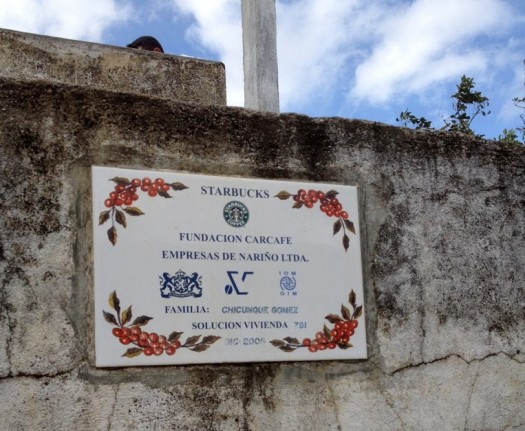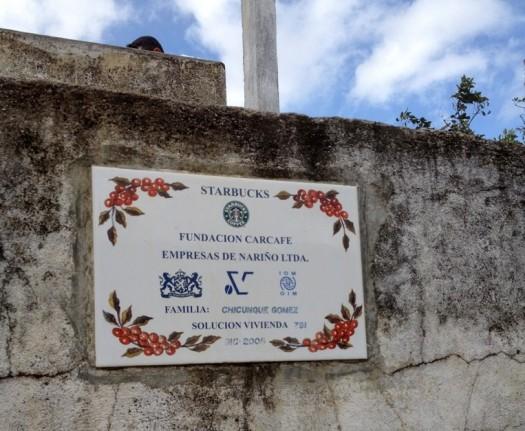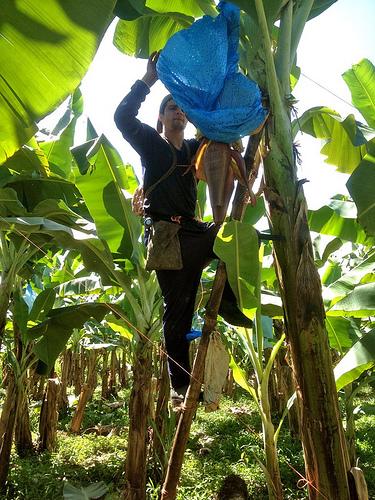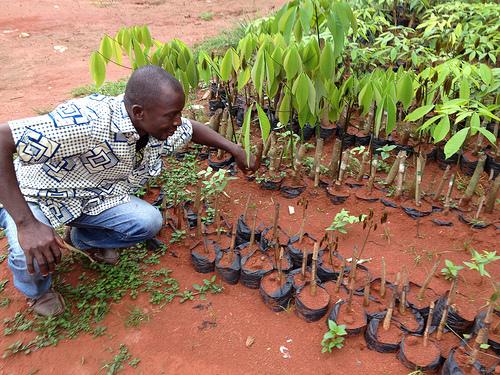
The Global Production of Our Food


Several years ago, fueled by his own curiosity, Kelsey Timmerman saved up his money and traveled the world to find out where his clothes came from. He visited garment factories in Asia and Latin America and ultimately turned his journey and research into a book called Where Am I Wearing? (Wiley, 2012), which is now part of the curriculum of many high-school and college courses across the US.
For his second book, Timmerman set out on another quest to research the global food movement. Where Am I Eating? (Wiley, 2013) investigates what the reliance on imported food means for Americans, as well as for the people around the world who produce our food.
Your book investigates the sources of five foods: coffee, chocolate, bananas, lobsters, and apple juice. Which one was the toughest to research and get answers on?
This is sort of like asking me to pick a favorite child. They were all tough in their unique ways.
Going into the project, I thought tracking my Starbucks coffee in Colombia would be easy. Starbucks talks a lot about the farmers they support in their marketing copy and as part of their corporate responsibility. Yet when I tried to contact them about locating their farmers, they told me that was proprietary information, so I was on my own.
I found the farmers who were included in the Starbucks C.A.F.E. Practices program (Starbucks’ own certification) in Colombia. It wasn’t that hard because they had Starbucks logos hanging on their homes. The strange part was that many of these farmers had never heard of Starbucks or been assisted by any program run by the company. When I asked the farmers who had hung the sign, their answer was usually “some guy.”
I quickly realized that no brands—including Red Lobster, Hershey’s, and Dole—were too eager to help me meet the folks responsible for producing their products. I think that says a lot.

What did you change about your own behavior after you researched and wrote the book?
I’ve completely changed the way I eat in so many ways. More than 60 percent of apple juice on the shelves in American grocery stores is made in China. Right away, my wife and I banned “Made in China” apple juice from our kids’ sippy cups. The list of Chinese food scares and scandals is long, including acres of watermelon exploding after a growth accelerator was applied, cadmium in rice, borax in pork, bleach in mushrooms, and arsenic in soy sauce and apple juice. The Chinese are scared of their own food system.
I know what you’re thinking. Don’t we inspect food that comes into the United States? Yes, we do. In the past decade the amount of food we import has doubled. We import 91 percent of seafood, 50 percent of our fresh fruit, and 20 percent of vegetables. Today we inspect about 2 percent of all imported food.
Overall, I’m trying to learn more about the people and the land responsible for producing the food I eat, and choosing to eat in a way that respects both, although it’s not always easy. A country-of-origin label in the grocery store will only tell you so much.
The Monterey Bay Aquarium’s Seafood Watch produces a great app to help consumers make responsible seafood choices. I’ve found it to be immensely useful, although maybe slightly annoying to the restaurant servers waiting on me.
I rarely eat fast food any longer; it’s just too unknowable.
I eat a lot more organic food than I used to. I’ve always been more interested in social justice than environmental justice. But farming alongside farmers around the world has shown me how the two are inseparable. Farmers are fighting against a global economy that pays them less and less. A cocoa farmer in Ivory Coast earns one-third of one penny for the cocoa in your Hershey’s bar, the Starbucks coffee farmer earns one cent for the coffee in your mocha latte. And they are facing a changing climate. I met farmers on four continents, and every one of them is struggling against climate change.
Now I eat way too much fair-trade chocolate and drink way too much fair-trade coffee. There has been a lot of discussion about what fair trade is and should be among the fair-trade community in the past year, but I think it is the second-best way to try to ensure that your food was respectful to man and land.
Of course, the only way to ensure that the farmer and environment are being treated right is to know the farmer, visit his farm, or grow your own food. We have about 100 square feet of garden now. We totally use child labor, all the time. Our four-year-old daughter, Harper, loves to pick cherry tomatoes. The problem is that she eats them all before they make it into the house.
You live in Muncie, Indiana, not a place known for its foodie culture or progressivism. I imagine it’s hard to eat and shop there the same way you could in, say, San Francisco. How do you approach it?
Actually, Muncie has a great local, organic grocery called the Downtown Farm Stand, which is one of only five all-organic grocers in the nation. The Downtown Farm Stand delivers produce to our doorstep once per week. It’s like Christmas! Dave and Sara Ring, the owners of the store, inspect many of the farms themselves. They were organic farmers looking for a way to get their product to market, and they decided someone should really open up a store to do just that. Now they’re too busy with the store to farm. When they can’t get something locally, they always get it certified organic and certified fair trade when possible. Fair-trade bananas aren’t the easiest things to find, but the Farm Stand has them!
Dave and Sara have very high standards for the products in their store. They are a trusted filter. I think that’s what every concerned consumer needs. If Muncie, Indiana, has such a store, you should probably be able to find a similar store where you live.
Every year, we hear a range of stories about how the foods Americans consume can have a detrimental effect on people elsewhere in the world. E.g., here’s a story from earlier this year on quinoa and how its popularity in the US may negatively impact Bolivians. It seems a common phenomenon that when foods gain popularity in the US, someone somewhere suffers. Or that the prosperity connected to a cash crop can have unintended consequences. What do you think? Are there a few specific principles US consumers could adopt that would make a difference in the lives of others who provide our food, if adhered to persistently?
We are the world’s greatest consumers. The average American consumes the amount of resources consumed by thirty-two Kenyans. So we need to consume responsibly, which of course isn’t always easy to do. Our appetites can be unquenchable.
As for the situation with quinoa: Its price has tripled since 2006. This improved the lives of many farmers in Bolivia, but for others who don’t grow quinoa, they can hardly afford the food that has been their staple food for generations. The UN actually declared 2013 the International Year of Quinoa because of the positive impact rising prices have had on the lives of [its] farmers.
Where I see a real concern is that these all-time-high prices could lead to overaggressive farming of quinoa on land that was once used as pasture or deemed unfit to grow the crop, which could lead to the long-term degradation of the land. Also, focusing too much on a single crop never ends well for farmers.
Markets collapse and blights happen. If the crop fails or the quinoa bubble bursts, and farmers suffer the results, our appetites won’t solely be to blame; it will also be the reaction of the Bolivian farmers to our appetites.
A fair-trade certification usually comes with crop diversity requirements, a set minimum price to farmers, and a social premium geared toward developing their village. Short of supporting fair trade, I’m not sure how to ensure that the long-term interests of the farmers are being looked after. (If you’re really concerned about the impact your quinoa addiction is having on the lives of farmers in the Andes, Alter-Eco sells fair-trade quinoa.)
There seems to be a strange backlash against eating local, or maybe it’s just backlash against foodie culture—that it privileges only those who have the money to buy locally sourced or organic food. (See this Slate article.) Thoughts?
I don’t wear skinny jeans, nor do I have black-framed glasses with prescription-less plastic lenses. My family hasn’t upped our intake of fair-trade and organic foods because it enhances the image we wish to put forth.
I understand the backlash. I do. Watching someone trying to express their moral superiority is rather unpalatable.
But we changed our diet for our kids. At the end of last summer, our world was rocked. My wife, Annie, took our eighteen-month-old son, Griffin, for a checkup. The pediatrician told Annie that he was concerned that Griffin might be on the autism spectrum. Since 2006, the incidences of autism in kids have increased from 1 in 110 to 1 in 50, according to the Centers for Disease Control and Prevention. No one is sure what has caused this, but the American Academy of Pediatrics thinks it might be connected to exposure to chemicals like pesticides. Who knows what has caused Griffin’s delays? But our entire family changed what we eat just in case. The majority of the produce and meat we eat is certified organic. We also had Griffin on a gluten- and casein-free diet for six months, but saw no change.
If a foodie is someone who gives a shit about what they’re feeding their kids, then, damnit, I’m a foodie. If a foodie is someone who cares that an overworked and underpaid father on a banana plantation in Costa Rica is exposed to fewer chemicals, then I’m a foodie.
I’ve held the babies of cocoa farmers in Ivory Coast and coffee farmers in Colombia. They love their kids, too. And if I can eat in a way that allows parents to provide their children with the lives of opportunities that they wish for them, I will.
The tragedy is that eating food produced in a way friendly to man and land can be out of reach for some family budgets. It’s not that they don’t love their kids enough to feed them fewer pesticides or that they don’t care about the producers’ families or the environment, it’s just that eating this way can be expensive and that choosing a $7 gallon of organic milk over a $2.50 gallon of milk doesn’t feel like you’re doing the right thing for your family when you’re having trouble paying bills.
Each of us needs to decide what we value and what we can afford.

You focused on international sources of the food we eat, but I wonder if you have any thoughts or experiences that offer insight into the recent Mother Jones piece by Ted Genoways (former VQR editor) on how US agriculture self-regulates and prevents consumers from knowing how their food is made.
My dad grew up on a farm with ducks, turkeys, hogs, cows, guineas, and chickens. He knew how to kill and pluck a chicken. He knew where his food came from and the process it took to get to his plate. Most of us don’t want to know. We don’t want to see the live lobster splash into the boiling water, the cow’s brain punctured, the living quarters of migrant workers. This is precisely why the food system has been able to enact efficiencies that, while more profitable, might not necessarily be the best for consumers.
The ag-gag law would prohibit journalists and activists from going undercover on farms. This seems like a logical reaction from an industry that is now faced with a public concerned about farming practices, one with things to hide. The fact that these laws are being proposed is proof that consumers who care about where their food comes from and how it is produced are changing the system.
If consumers don’t express their concerns, and don’t change their buying habits if they can afford it, the global food chain will stretch further and become even more unknowable.
To find out more about Timmerman’s books and travels, visit his website. You can also view more photos at his Flickr account.

